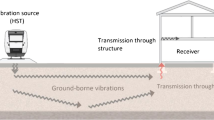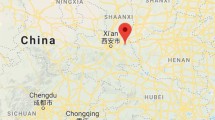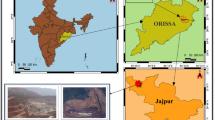Abstract
Ground vibration, as the most critical public hazard of blasting, has received much attention from the community. Many countries established national standards to suppress vibration impact on structures, but a world-accepted blasting vibration criterion on human safety is still missing. In order to evaluate human response to the vibration from blasting excavation of a large-scale rock slope in China, this study aims to suggest a revised criterion. The vibration frequency was introduced to improve the existing single-factor (peak particle velocity) standard recommended by the United States Bureau of Mines (USBM). The feasibility of the new criterion was checked based on field vibration monitoring and investigation of human reactions. Moreover, the air overpressure or blast effects on human beings have also been discussed. The result indicates that the entire zone of influence can be divided into three subzones: severe-annoyance, light-annoyance and perception zone according to the revised safety standard. Both the construction company and local residents have provided positive comments on this influence degree assessment, which indicates that the presented criterion is suitable for evaluating human response to nearby blasts. Nevertheless, this specific criterion needs more field tests and verifications before it can be
Similar content being viewed by others
References
Afeni TB and Osasan SK (2009), “Assessment of Noise and Ground Vibration Induced During Blasting Operations in an Open Pit Mine—A Case Study on Ewekoro Limestone Quarry, Nigeria,” Mining Science and Technology (China), 19(4): 420–424.
DIN 4150 (1999), Vibration in Buildings-Part 3: Effects on Structures, Germany Norm, Germany Standard Institute.
Dong Shuang and Zhu Yuanqing (2004) “Ef fects of Environmental Vibration on Man,” Controlling of Vibration and Noise, 24(3): 22–25. (in Chinese)
Dowding CH (1996), Construction Vibrations, Prentice Hall, Upper Saddle River, NJ, USA.
Dowding CH and Siebert D (2000), “Control of Construction Vibrations with an Autonomous Crack Comparometer,” Explosives and Blasting Technique, R. Holmberg, Ed., AA Balkema, pp.103–110.
Duvall WI and Fogelson DE (1962), Review of Criteria for Estimating Damage to Residences from Blasting Vibrations, No. BM-RI-5968, Bureau of Mines, College Park, MD (USA).
Edwards AT and Northwood TD (1959), E xperimental Blasting Studies, National Research Council, Ottawa, Canada.
Griffin MJ (1990), Handbook of Human Vibration, San Diego: Academic Press Ltd., pp.988.
GB6722-2014 (2014), Safety Regulations for Blasting, China Society of Engineering Blasting, Standards Press of China, Beijing, China. (in Chinese)
ISO2631-1 (1997), Mechanical Vibration and Shock-Evaluation of Human Exposure to Whole-body Vibration-Part 1: General Requirements, International Organization for Standardization.
IS O8041 (2005), Human Response to Vibration and Measuring Instrumentation, International Organization for Standardization.
Jimeno EL, Jimino CL and Carcedo A (1995), Drilling and Blasting of Rocks, CRC Press, Florida, USA.
Kuzu C and Ergin H (2005), “An Assessment of Environmental Impacts of Quarry-blasting Operation: a Case Study in Istanbul, Turkey,” Environmental Geology, 48(2): 211–217.
Kuzu C and Guclu E (2009), “The Problem of Human Response to Blast Induced Vibrations in Tunnel Construction and Mitigation of Vibration Effects Using Cautious Blasting in Half-face Blasting Rounds,” Tunnelling and Underground Space Technology, 24(1): 53–61.
Langefors U, Kihlstrom B and Westerberg H (1958), Ground Vibrations in Blasting, Nitrogglycerin Aktiebolaget, Water Power, Part I-III, pp. 335-338, 390-395, 421-424.
Lu Wenbo et al. (2012), “An Introduction to Chinese Safety Regulations for Blasting Vibration,” Environmental Earth Science, 67(7): 1951–1959.
Nicholls HR, Johnson CF and Duvall WI (1971), Blasting Vibrations and Their Effects on Structures, No. BM-BULL-656, Bureau of Mines, Denver, CO (USA), Denver Mining Research Center.
Oriard LL (1972), “Blasting Effects and Their Control in Open Pit Mining,” Proceedings of the Second International Conference on Stability in Open Pit Mining, Edited by CO Brawner and V Milligan, Geotechnical Practice for Stability in Open Pit Mining, Society of Mining Engineers, Vancouver, BC, pp.197–222.
Oriard LL and Emmert MW (1980), “Short-delay Blasting at Anaconda’s Berkeley Open-pit Mine,” Montana Pres, at AIME Annual Meeting, Las Vegas, NV, Feb. 24-28, Soc. Min. Eng. AIME preprint, pp. 60–80.
Siskind DE et al. (1980), Structure Response and Damage Produced by Ground Vibration from Surface Mine Blasting, No. BM-RI-8507, Bureau of Mines, Twin Cities, MN (USA), Twin Cities Research Center; Northwestern Univ., Evanston, IL (USA).
Walter EJ and Walter Jr EJ (1979), “Low Level Continuous Vibration and Potential Damage,” Gen Proc Ann Conf Explosives and Blasting Res ISEE CD-ROM database.
Wiss JF and Parmelee RA (1974), “H uman Perception of Transient Vibrations,” Journal of the Structural Division, 100(ST4): 773–787.
Zhang Xiangdong et al. (2008), “Effects of Environmental Vibration on Human Health,” Journal of Environment Health, 25(1): 74–76. (in Chinese)
Zhu Guanghan and Wang Zhengling (1992), “Assessment of Effects of Incident Vibration or Environmental Vibration on Humans and Its Criterion,” Vibration and Impaction, 43(2): 67–70. (in Chinese)
Acknowledgement
This research is supported by the Chinese National Programs for Fundamental Research and Development (973 Program) (2011CB013501), the Chinese National Science Fund for Distinguished Young Scholars (No. 51125037) and the Chinese National Natural Science Foundation (Nos. 51179138, 51279135, 51279146 and 51009013). The authors sincerely express their thanks for this support.
Moreover, the authors express their special thanks to the Bai-he-tan Project Construction Department of China Three Gorges Corporation and the local government for their help during the field blasting vibration monitoring and investigation of the local residences.
Author information
Authors and Affiliations
Corresponding author
Additional information
Supported by: the Chinese National Programs for Fundamental Research and Development (973 Program) under Grant No. 2011CB013501, the Chinese National Science Fund for Distinguished Young Scholars under Grant No. 51125037 and the Chinese National Natural Science Foundation under Grant Nos. 51179138, 51279135, 51279146 and 51009013
Rights and permissions
About this article
Cite this article
Yan, P., Lu, W., Zhang, J. et al. Evaluation of human response to blasting vibration from excavation of a large scale rock slope: A case study. Earthq. Eng. Eng. Vib. 16, 435–446 (2017). https://doi.org/10.1007/s11803-017-0391-z
Received:
Accepted:
Published:
Issue Date:
DOI: https://doi.org/10.1007/s11803-017-0391-z




